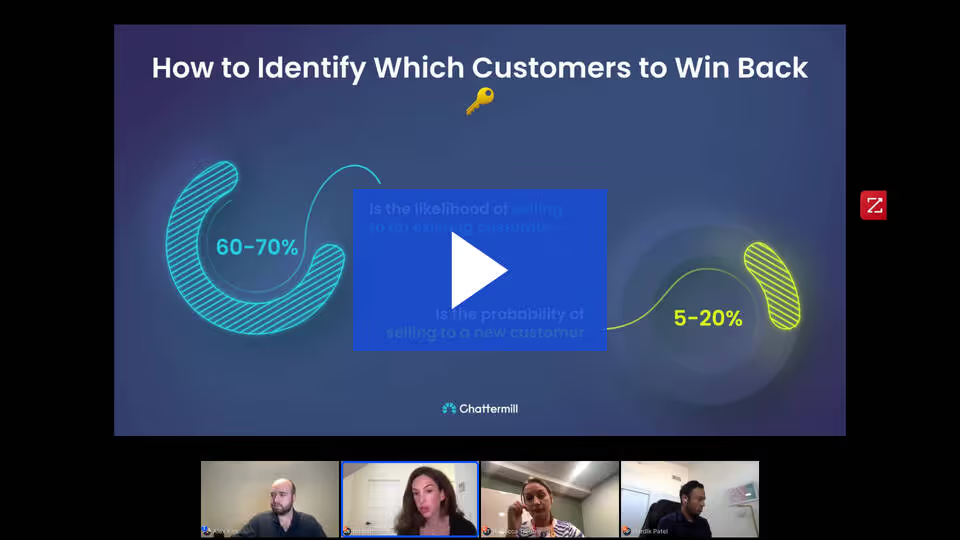The latest episode in our CX leaders roundtable webinar series looks at customer churn.
This past Thursday, we were pleased to welcome three special guests: Ro Nattiv, Senior Director Of Customer Experience at MeUndies, Rebecca Trebble, Head of Customer at The Very Group, and Hardik Patel, Director of Growth, Retention, Loyalty and Customer Strategy at FabFitFun. All are working in customer experience across the retail sector. And all have a unique and valuable perspective on the impacts of customer churn today.
Read on for our key takeaways from the discussion. Want to catch up again? The entire webinar is available to watch in the video below.

CX Leaders Roundtable: How to Win Back Churned Customers - Chattermill
Why Avoidable Churn is So Bad For Your Business
‘Generally speaking, any churn is not good for business.’ Ro Nattiv of MeUndies says. ‘It’s the loss of a customer and revenue that could have come from that customer. That said, some churn is completely avoidable.’
‘Losing customers to something that you had the ability to solve should not be a factor that is impacting your customer retention,’ she adds.
.avif)
Nattiv also points out that acquiring new customers costs more than retaining them.
‘It should be one of the key KPIs for your company, especially if you are in CX.’
The Very Group’s Rebecca Trebble agrees. ‘Within retail, there is sometimes a churn that can be experienced where you’ve cast your net quite wide to attract a group of customers to try your offer,’ she says. ‘For some people, that offer will absolutely resonate, and for others, it may be less so. And then, for some, they may feel that isn’t quite what they are looking for.’
For Trebble, CX specialists need to be alive to these issues that can cause this avoidable churn.
So when it comes to churn rates, are our guests seeing more churn today?
For Nattiv, the reasons customers are giving for leaving are changing more than the rates of churn themselves over the last six months. These include economic factors, layoffs, and rising inflation, causing consumers to tighten their belts.
For Hardik Patel, the factors affecting Nattiv’s customers are forcing his business to push up prices – which has increased churn rates. Trebble, on the other hand, is unsure whether customers who are buying less frequently during this period of financial hardship will churn completely or start buying more regularly again when things aren’t so economically difficult.
How to Identify Which Customers to Win Back
‘When we first started, I think we cast a much wider net trying to win back churned customers,’ Nattiv says. ‘We quickly realised that it is just going to burn through resources.’
MeUndies quickly found that the best path forward for them was to be more strategic and focus on customers who fit the brand best.
%20(1).avif)
Similarly, Trebble describes her work at The Very Group, which segments the customer base and pairs this with CLTV metrics.
The engagement they then carry out with those customers who have recently lapsed will align with how much value they have as a consumer. Trebble describes that even those customers who are relatively new to Very can be assessed alongside those longer-term users with similar shopping characteristics.
For Patel, his brand is membership-based, so every customer has more long-term value than the everyday shopper.
‘We do have some segmentations,’ he says. ‘Super queens and queens. And then annual and seasonal. We do need to do a better job as a company. We are heavily marketing the cohorts, but then our merch team have stepped up on newness and promoting new deals and new products to the customers so that they stay with us or come back.’
So should we be trying to win back all customers?
For Trebble, this is where CLTV is so essential. ‘In some cases, you may acquire certain customers, and you know that maybe they’re not going to be there for the long term,’ she says. ‘Maybe even the time spent trying to engage with those customers could be spent on more highly valuable customers.’
For Nattiv and Patel, it boils down to bandwidth and finances – bigger brands may be able to cast their net as wide as possible, winning back customers who might, on paper, have lower CLTVs, but many smaller or niche brands will simply not be able to do so.
How to Win Back Churned Customers and Reduce Future Churn
‘Before our customer gets to the point of churn, you absolutely want to have, wherever possible, avoided that from happening,’ Trebble says. ‘So there’s one thing about trying to win them back from a churned position, and another is trying to stop them on their journey and intervene at the right points to avoid a churning impact.’
%20(1).avif)
Of course, data is massively important here.
Suppose a consumer has had a bad customer experience. In that case, Trebble and her team will know why and will be able to target them directly, accept responsibility for what wasn’t right, and then resolve the issue.
Additionally, if a consumer is buying less frequently or browsing the site with less regularity, Very can intervene to try and stop that churn before it happens.
‘It’s one thing to know and understand why your customers are leaving,’ Nattiv adds, ‘but it’s another thing if you are not acting on that.’
In short, brands need to be constantly listening to their customers. They need to accept customer feedback, resolve problems, and promote those things users say are positive or valuable to them.
‘There’s always something that we learn each season,’ Patel says. ‘Sometimes there are shipping issues. Sometimes it’s the product issue. Sometimes it’s the marketing…also we have a more scientific way of identifying who as a customer is more likely to churn with us based on some previous cancel behaviour. And we map that into our modelling and communication.’
Regarding winning back customers, Patel uses credit and gifts to lure back users from specific segments – but is mindful of engendering cherry-picking behaviour where customers will only remain loyal to get these perks.
For him, it is essential to promote newness with products, as well as reasonable prices and excellent fulfilment experiences to ensure his customers are always delighted and will return season to season.
‘For me, it comes back to that value balance,’ Trebble says. ‘If I have to increase my prices, how can I ensure the range is better? Or how can I make sure that I’ve got speedy delivery? Or how can I make sure I’ve got delivery choices?’
‘For us, it’s definitely about creating that balance of, if I am doing this, how can I make sure that what you are receiving as a total package is definitely still valuable to you as a customer,’ she adds. ‘To do that, you have to understand and have done the analysis to know what the customers really value about what you offer.’
Nattiv also points to the importance of transparency here. Customer feedback needs to be visible to every department at MeUndies – ensuring that everyone understands that bad CX in a certain area will impact churn rates and, ultimately, revenue.
Being able to share insights across the whole organisation is vital. And this is something that Chattermill’s Unified Customer Intelligence platform is built for.
‘Until we did have Chattermill as our dashboard, there wasn’t that visibility,’ Nattiv says. ‘We had 16 different data sources. None of them talked to each other. Limitations of licenses. And then coming on to Chattermill, where all this feedback is now housed in a central location, has been incredibly impactful.’
Watch the Customer Churn Webinar Again

CX Leaders Roundtable: How to Win Back Churned Customers - Chattermill


%20(1).avif)












